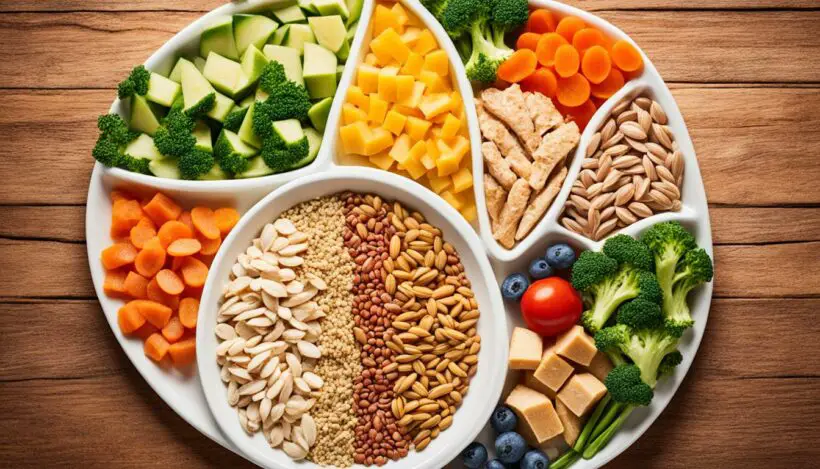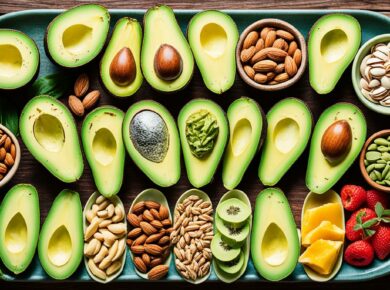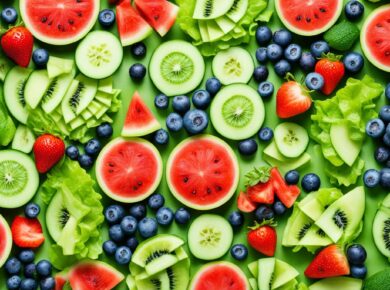Insulin resistance is a condition that affects the body’s ability to properly respond to insulin, a hormone that regulates blood sugar levels. If left unmanaged, insulin resistance can lead to the development of diabetes.
One of the key strategies in combating insulin resistance is making the right dietary choices. By adopting an insulin resistance diet, individuals can improve insulin sensitivity, manage blood sugar levels, and support overall metabolic health.
In this article, we will explore the causes and symptoms of insulin resistance, as well as the various treatments and diet strategies that can effectively combat this condition. We will also delve into the research surrounding insulin resistance and provide helpful tips for success on an insulin resistance diet.
Understanding Insulin Resistance and its Link to Diet
Insulin is a hormone that plays a crucial role in the body’s metabolism, specifically in the absorption of glucose by cells. Insulin resistance occurs when the body’s cells fail to respond adequately to the insulin produced by the pancreas, leading to elevated blood sugar levels. This condition is associated with various factors, including excess fat storage around organs and the consumption of high glycemic index foods.
Diet plays a significant role in managing insulin resistance. By making informed choices about the foods we eat, we can positively impact our insulin sensitivity and overall health. Personalized nutrition plans are particularly beneficial in identifying the best foods for our individual body’s response to insulin.
Foods high in refined sugars and carbohydrates, such as sugary drinks and processed snacks, can contribute to insulin resistance and weight gain. On the other hand, a well-balanced diet that includes whole foods, lean protein sources, and healthy fats can support insulin sensitivity and help manage blood sugar levels.
Research on insulin resistance and its link to diet is ongoing, with scientists exploring various approaches to treatment and prevention. By staying up to date on the latest research findings, we can make more informed decisions about our dietary choices and better manage insulin resistance.
Foods to Include in an Insulin Resistance Diet
The American Diabetes Association recommends a personalized nutrition approach for managing insulin resistance. However, there are some general guidelines that can be followed. These include:
-
Increase Fiber Intake
Incorporate whole grains into your meals to boost fiber intake. Whole grains like oatmeal, quinoa, and brown rice provide sustained energy and help regulate blood sugar levels.
-
Incorporate Foods Rich in Polyunsaturated Fats
Include foods like avocados, nuts, and seeds, which are rich sources of healthy fats. These fats promote satiety, aid in weight management, and can improve insulin sensitivity.
-
Focus on Non-Starchy Vegetables
Non-starchy vegetables such as leafy greens (spinach, kale), cruciferous vegetables (broccoli, cauliflower), and tomatoes are low in carbohydrates and high in nutrients. They can be enjoyed in abundance without significantly impacting blood sugar levels.
-
Choose Whole Foods Over Processed Options
Avoid processed and refined foods as they are often high in added sugars and unhealthy fats. Opt for whole foods like fruits, vegetables, lean proteins, and whole grains instead.
Specific examples of insulin-friendly foods that can be included in an insulin resistance diet are:
- Leafy greens like spinach, kale, and Swiss chard
- Cruciferous vegetables such as broccoli, cauliflower, and Brussels sprouts
- Tomatoes
- Asparagus
- Whole grains like oats, quinoa, and brown rice
- Beans and legumes
- Fish rich in omega-3 fatty acids like salmon and tuna
- Lean protein sources such as chicken and turkey
- Nuts and seeds like almonds, walnuts, and flaxseeds
These foods provide essential nutrients and can help improve insulin sensitivity, manage weight, and support overall metabolic health.
Foods to Avoid for Insulin Resistance
To effectively manage insulin resistance, it is crucial to limit or avoid certain foods that can exacerbate the condition. By making mindful dietary choices, individuals can better control their blood sugar levels and support their overall health.
Avoid Sugary Drinks
Sugary drinks like soda and fruit juices are high in added sugars and can cause rapid increases in blood sugar levels. These beverages provide little to no nutritional value and can contribute to weight gain, which further worsens insulin resistance. Opt for water, unsweetened teas, or flavored water with no added sugars as healthier alternatives.
Limit Refined Carbohydrates
Refined carbohydrates, such as white rice and white bread, have been processed and stripped of fiber and nutrients. These foods are quickly digested and can cause sharp spikes in blood sugar levels. Instead, choose whole grain alternatives like brown rice, quinoa, and whole wheat bread, which provide more fiber and essential nutrients.
Avoid Ultra-Processed Snack Foods
Ultra-processed snack foods like cookies and chips are often high in unhealthy fats, added sugars, and refined carbohydrates. These foods not only contribute to weight gain but also lead to increased inflammation and insulin resistance. Opt for healthier snack options like fresh fruit, raw nuts, seeds, or homemade snacks made with whole food ingredients.
By minimizing the intake of sugary drinks, refined carbohydrates, and ultra-processed snack foods, individuals can significantly improve their insulin resistance and support their overall well-being.
Tips for a Successful Insulin Resistance Diet
Making changes to your diet can be challenging, especially when it comes to managing insulin resistance. However, by following some simple tips, you can set yourself up for success on your insulin resistance journey.
- Take small, manageable steps: Instead of attempting a drastic overhaul of your diet, focus on making small changes that you can sustain over time. This approach can help you avoid feeling overwhelmed and increase your chances of long-term success.
- Prioritize regular meals: Eating regular, balanced meals can help stabilize your blood sugar levels and prevent sudden spikes or drops. Aim for three meals a day and consider incorporating healthy snacks in between to keep your blood sugar steady.
- Pair carbohydrates with fiber, protein, or fat: When consuming carbohydrates, such as grains or starchy vegetables, pair them with sources of fiber, protein, or healthy fats. This combination can help slow down the digestion of carbohydrates and prevent rapid increases in blood sugar levels.
- View setbacks as learning opportunities: It’s important to remember that making dietary changes takes time and effort. If you experience setbacks or slip-ups, don’t beat yourself up. Instead, use them as learning opportunities to understand what triggered the setback and how you can avoid it in the future.
- Choose low glycemic index foods: Low glycemic index (GI) foods are digested and absorbed more slowly, resulting in a gradual release of glucose into the bloodstream. These foods can help maintain more stable blood sugar levels throughout the day. Incorporate foods like berries, leafy greens, whole grains, and lean proteins into your meals.
By following these tips, you can make positive changes to your diet to support insulin sensitivity and manage insulin resistance effectively.
The Glycemic Index and Blood Sugar Control
The glycemic index (GI) is a measure of how different foods affect blood sugar levels. Understanding the GI of specific foods can play a vital role in managing blood sugar levels, especially for individuals with insulin resistance.
Foods with a high GI are quickly digested and absorbed, causing a rapid increase in blood sugar. On the other hand, low GI foods are digested and absorbed more slowly, resulting in a slower and more controlled impact on blood sugar levels. By incorporating more low GI foods into your diet, you can help prevent spikes in blood sugar and maintain stable levels throughout the day.
It’s important to note that the GI score alone doesn’t provide the complete picture. Factors like portion sizes and individual responses to food also influence blood sugar control. However, the GI can serve as a useful guideline when planning meals and choosing foods that promote better blood sugar management.
To give you a better idea, here are a few examples of low GI foods that you can include in your insulin resistance diet:
- Vegetables: Broccoli, spinach, kale, cauliflower, and zucchini.
- Fruits: Berries, apples, oranges, and cherries.
- Legumes: Chickpeas, lentils, kidney beans, and black beans.
- Whole Grains: Oats, quinoa, brown rice, and whole wheat bread.
By incorporating these low GI foods into your insulin resistance diet, you can support better blood sugar control and overall metabolic health.
The Role of Fiber in Managing Insulin Resistance
Fiber plays a crucial role in managing insulin resistance by slowing down digestion, releasing sugar gradually, and increasing satiety. Including foods high in fiber in your insulin resistance diet can promote stable blood sugar levels and aid in weight management. Examples of high-fiber foods include:
- Whole grains
- Fruits
- Vegetables
- Legumes
These fiber-rich foods not only provide essential nutrients but also help support insulin sensitivity and balance blood sugar levels. Consuming more than 50 grams of fiber per day can be particularly beneficial for managing insulin resistance. By incorporating fiber into your diet, you can take a proactive approach towards improving your insulin sensitivity and overall metabolic health.
The Importance of Omega-3 Fatty Acids in Insulin Resistance
Omega-3 fatty acids play a crucial role in managing insulin resistance due to their anti-inflammatory properties and their ability to improve insulin sensitivity. Including foods rich in omega-3 fatty acids in your insulin resistance diet can help reduce inflammation and promote a better insulin response.
Fatty fish such as salmon, mackerel, and sardines are excellent sources of omega-3 fatty acids. These fish not only provide essential nutrients but also contribute to better insulin sensitivity. Adding them to your meals can support your efforts in combating insulin resistance and managing blood sugar levels effectively.
In addition to fish, nuts and seeds like flaxseeds and walnuts are also rich in omega-3 fatty acids. Adding a handful of these nutritious foods to your snacks or incorporating them into your recipes can further enhance your omega-3 intake and support your insulin resistance diet.
Remember, omega-3 fatty acids have numerous health benefits beyond insulin resistance. They are known to support heart health, brain function, and reduce the risk of chronic diseases. So, including omega-3-rich foods in your diet can have far-reaching positive effects on your overall well-being.
To visually illustrate the importance of omega-3 fatty acids in managing insulin resistance, take a look at the image below:
By incorporating omega-3-rich foods into your diet, you can reduce inflammation, improve insulin sensitivity, and support your overall metabolic health. While omega-3 fatty acids are beneficial, it is important to consult a healthcare professional before making significant dietary changes.
Magnesium and its Role in Insulin Sensitivity
Magnesium is an essential mineral that plays a crucial role in insulin signaling and glucose regulation. Adequate levels of magnesium in the body can significantly improve insulin sensitivity and help regulate blood sugar levels effectively. By incorporating foods rich in magnesium into the diet, individuals can support their insulin sensitivity and overall metabolic health.
Foods that are excellent sources of magnesium include:
- Leafy green vegetables like spinach and kale
- Fruits such as avocados and bananas
- Nuts and seeds like almonds, cashews, and pumpkin seeds
- Whole grains like brown rice and quinoa
- Legumes such as lentils and black beans
By including these magnesium-rich foods in your insulin resistance diet, you can provide your body with the necessary nutrients to support insulin sensitivity. Remember to consult a healthcare professional before making any significant dietary changes.
Vitamin D and its Impact on Insulin Resistance
Vitamin D plays a crucial role in regulating insulin secretion and sensitivity, making it an essential nutrient for managing insulin resistance. Low levels of vitamin D are associated with an increased risk of insulin resistance, highlighting the importance of maintaining adequate vitamin D levels.
Fatty fish like salmon, trout, and mackerel are excellent sources of vitamin D. Including these fish in your insulin resistance diet can help improve vitamin D levels and support overall metabolic health. Fortified foods such as milk, yogurt, and breakfast cereals are also good sources of vitamin D.
Additionally, exposure to sunlight is a natural way to boost vitamin D levels. Spending time outdoors and allowing your skin to be exposed to the sun’s rays can help your body produce vitamin D. However, be mindful of sun safety and avoid prolonged exposure without sunscreen.
To summarize, ensuring an adequate intake of vitamin D is crucial for supporting insulin sensitivity and managing insulin resistance. Including fatty fish, fortified foods, and embracing sunlight as sources of vitamin D can play a beneficial role in your insulin resistance diet.

Protein for Insulin Sensitivity and Muscle Health
When it comes to managing insulin resistance and supporting overall health, protein plays a crucial role. Not only does it help maintain muscle mass, but it also helps stabilize blood sugar levels. Adequate protein intake can improve insulin sensitivity and promote weight management, making it an essential component of an insulin resistance diet.
There are various sources of protein that can be included in your meals. Lean meats such as chicken and turkey, eggs, dairy products like Greek yogurt and cottage cheese, legumes such as lentils and chickpeas, and nuts and seeds are all excellent options. These protein-rich foods provide essential amino acids and other nutrients necessary for optimal muscle function and insulin regulation.
Incorporating protein into your meals can help you feel fuller for longer, reducing the temptation to reach for unhealthy snacks. It also supports muscle growth and repair, contributing to a healthier body composition and metabolism.
To ensure a balanced diet, aim for a variety of protein sources throughout the day. For instance, you can have scrambled eggs for breakfast, grilled chicken breast for lunch, Greek yogurt with nuts for a snack, and lentil curry for dinner. This diversity helps you meet your protein needs and enjoy a range of flavors and textures.
Remember, if you have any specific dietary restrictions or health conditions, consult a healthcare professional or a registered dietitian for personalized advice. They can help you determine the appropriate amount of protein for your insulin resistance diet and recommend suitable options based on your individual needs.
Including protein-rich foods in your insulin resistance diet can contribute to better insulin sensitivity, muscle health, and overall well-being. By making informed choices and incorporating a variety of protein sources into your meals, you can support your body’s insulin regulation and manage insulin resistance effectively.
Conclusion
Managing insulin resistance and improving overall health requires making dietary changes. Personalized nutrition plans based on individual responses to food can provide the most effective approach for combating insulin resistance. By incorporating foods that promote insulin sensitivity and limiting those that worsen insulin resistance, individuals can take control of their insulin levels and support their well-being.
The key to success is making sustainable changes to eating habits. Incorporating foods such as leafy greens, whole grains, fish, lean proteins, and nuts and seeds can help improve insulin sensitivity. On the other hand, it is important to limit or avoid sugary drinks, refined carbohydrates, and ultra-processed snack foods which can contribute to insulin resistance and weight gain.
Ultimately, consulting a healthcare professional before making any significant changes to the diet is important. With the right guidance and support, individuals can effectively manage insulin resistance, regulate blood sugar levels, and improve their metabolic health.






